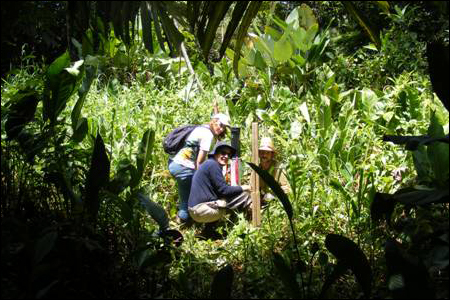Water Balance, Seasonal Hydroperiod Variation and Time of Residence of a Small Natural Freshwater Wetlands in the Humid Tropics in Costa Rica
Participants: David Kaplan, Manon Bachelin, Rafael Muñoz-Carpena (UF); Warner Rodriguez, Julio Tejada, Faelen Tais Kolln, Maria Floridalma Miguel Ros, Natalia Solano (EARTH University)
Timeline: May 2008 – present
Funding Agencies: UF Graduate School Office of Research
Project Summary
Hydrological studies of tropical wetlands have focused on large systems, and scant information is available on the role of smaller wetlands in the tropics. Central American wetlands are generally small and their abundance and ubiquitous distribution reinforce the importance of their environmental functions.
This study was conducted in a small (<10 ha), freshwater, tropical wetland with a single outlet and no specific inlet in Costa Rica and offers an opportunity to evaluate the complex and dynamic system during one year of monitoring. Objectives were to quantify the components in the water balance, to identify the storage and water surface variation and frequency, and to assess the stability of the hydrologic response and the natural water quality improvement potential. A dual surface water tracer experiment was also conducted to assess the feasibility of using sulfur hexafluoride as a surface water tracer under humid tropical and slow flow conditions.

Detailed experimental time series of water surface elevation and meteorological data were used to quantify hydrologic inputs and outputs of the wetland, allowing for calculation of the water balance and storage capacity. Combining the time series data with a topographical survey allowed for the quantification of flooding and water volume frequency. Stability of the hydrologic response of the wetland was shown during the year, with the exception of some extreme events. These results show that the wetland self-regulated naturally during the year. Variation of water extent and volume were small. The stability and low flow characterizing the wetland improved its water quality treatment with a natural removal potential of 70-92% of incoming surface water pollutants for 95% of the calculated residence times.
Chemical analysis and initial interpretation of tracer study results showed that sulfur hexafluoride was not an appropriate tracer for this location because of its non-conservative behavior caused by strong volatilization during transport. Bromide results showed different time to peak concentrations that were coupled with distances between sampling sites to give flow paths and estimated velocities of tracer plumes. Average velocities were low (6.8 to 26 m/day) and in the same range as residence time calculations from the parallel hydrological monitoring study. Our results indicate that flows in the studied wetland, although spatially heterogeneous, are stable and slow, supporting its high water treatment potential.
Resource Links
Publications
Refereed Publications
- Kaplan, D., M. Bachelin, R. Muñoz-Carpena, and W. Rodriguez. 2010. The hydrological role of small freshwater wetlands in the humid tropics: a Costa Rican case study. Wetlands (submitted).
- Bachelin, M., D. Kaplan, R. Muñoz-Carpena, and B. Gao. Multi-tracer study in a small, natural wetland in the humid tropics of Costa Rica (in preparation/submision)
Reports
- Manon Bachelin, 2009. Water Balance, Seasonal Hydroperiod Variation and Time of Residence of a Small Natural Freshwater Wetlands in the Humid Tropics in Costa Rica[7.16MB]. M.Sc. thesis. Civil and Environmental Engineering, Swiss Federal Institutes of Technology (EPFL), Laussane, Switzerland.
Presentations & Posters
- Bachelin, M. Water balance, seasonal hydroperiod variation, and residence time of a small, natural wetland in the humid tropics of Costa Rica. Annual Meeting of the American Society of Agricultural and Biological Engineers, Florida Section, July 2009, Daytona Beach, FL.
This page was last updated on July 13, 2019.